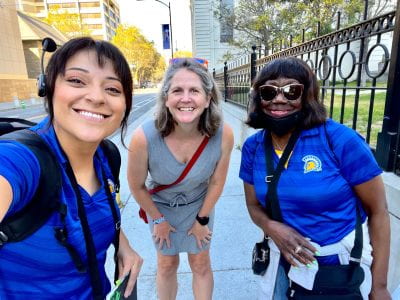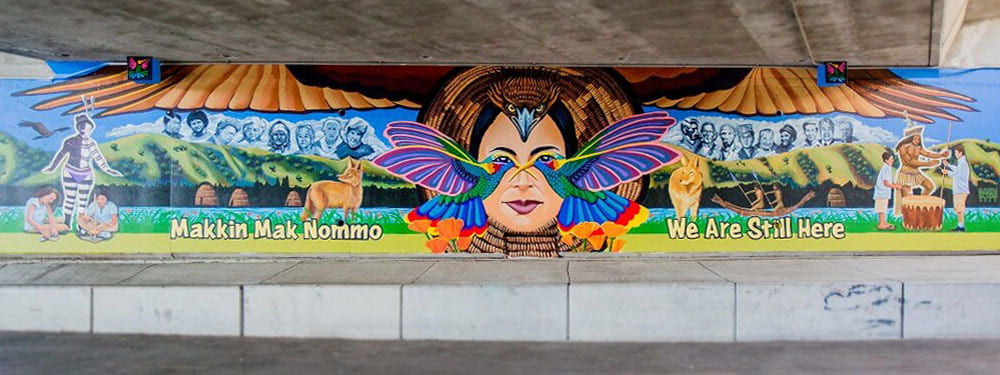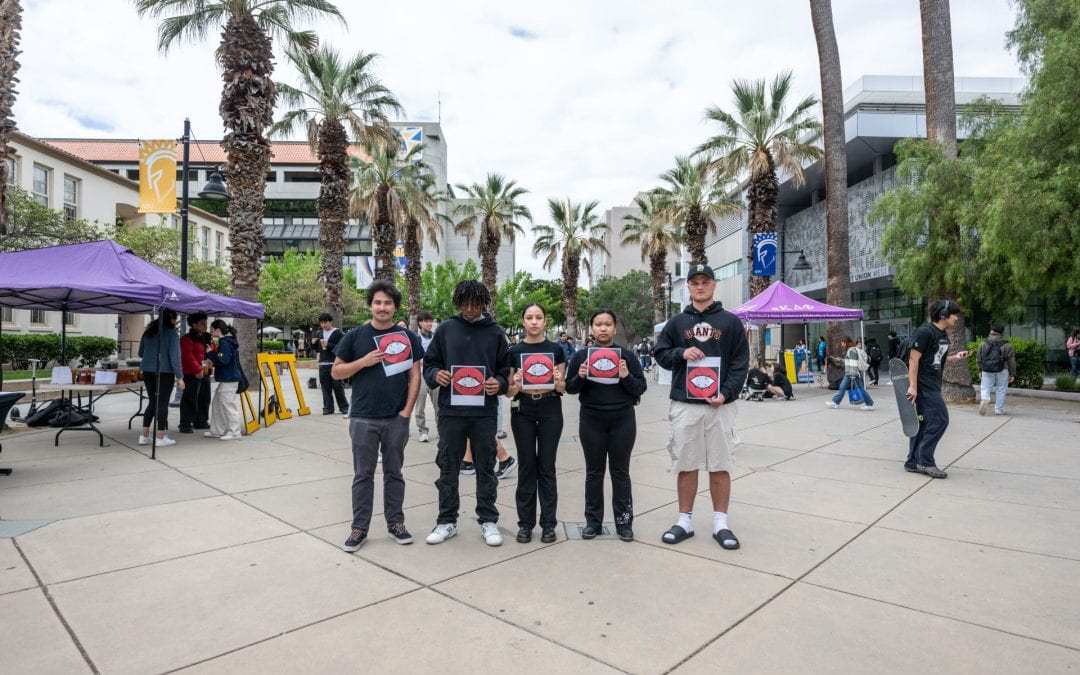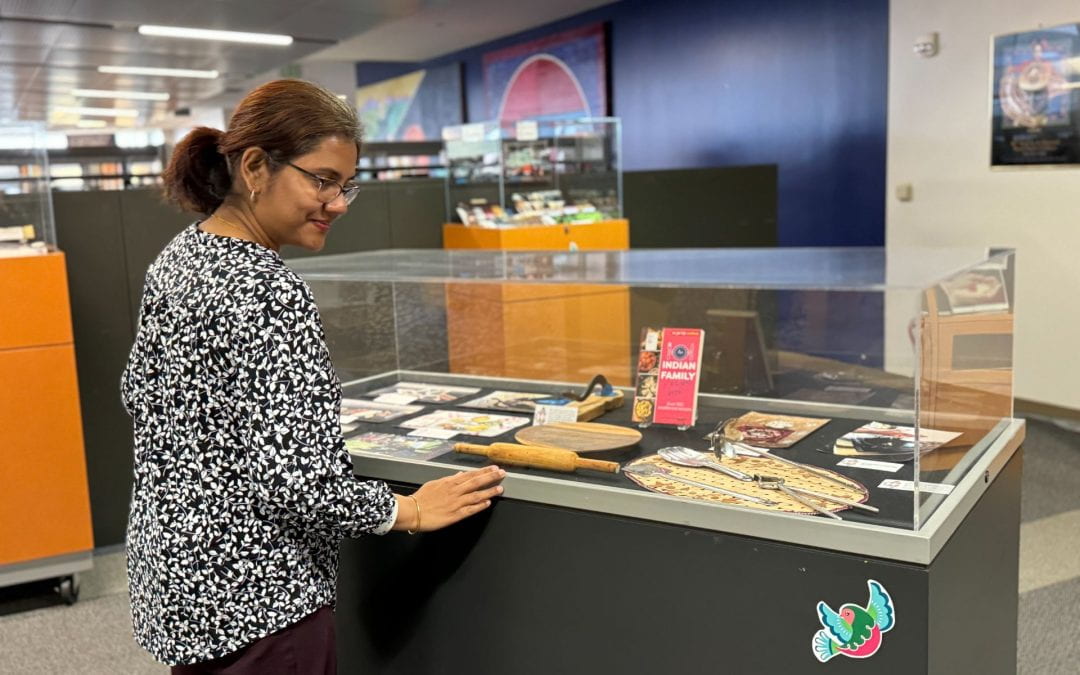SJSU Student Leads Free Public Art as Resistance Tours Available March 25 – April 16

Lou Jiménez (far right, blue shirt), offers insight on “Celebration Under Water,” a mural by Harumo Sato on Dac Phuc restaurant in downtown San José as part of a Public Art as Resistance tour. Photo by Katherine D. Harris.
Editor’s note: Thanks to funding from a City of San José Abierto grant, the College of Humanities and the Arts will be offering three in-person walking tours on March 25, April 2, April 8 (in Spanish), and April 16. Tours start at 10 a.m. and are limited to 20 people. Registration is required but free. Meet at the César Chávez Arch at San José State (“The Arch of Dignity”). The story below was originally published in December 2022.
For Lourdes “Lou” Jiménez, ’23 Art History, the impact of public art multiplies when experienced by bicycle, on foot and in the communities that surround us.
Lou Jiménez can’t say enough about Ruth Asawa’s “Japanese American Internment Memorial.” The bronze-bas relief stands at the entrance to San José’s Federal Building and depicts life for Japanese Americans before and after the incarceration of more than 100,000 individuals during World War II. The piece, though arresting, is often overlooked amidst the hubbub of downtown San José.
“I enjoy talking about this piece because it’s very site-specific, not only to the Federal Building, but to San José State, which was itself a registration site for local residents of Japanese descent in 1942,” said Jiménez.
“Public art is existence. It’s the now. It’s the present. Everybody knows that once you put your art out there as a public artist, it belongs to the world.”
The monument underscores Jiménez’s long-held belief in the power of art to express the intersectional history of place — a tangible reminder of people who came before. She enjoys sharing the story of Asawa’s piece with community members who sign up to attend a Public Art as Resistance tour offered through San José State University’s College of Humanities and the Arts. The project investigates the history of resistance embedded in downtown San José’s public art.
Started in fall 2021 by an interdisciplinary team of faculty and students, and supported by a Humanities for All Quick Grant from the California Humanities Council, a non-profit partner of the National Endowment for the Humanities, the walking tours offer in-depth analysis of 12 sites, murals and monuments that provoke community dialogue and engagement. The tours are an extension of the college’s Geography of the Arts initiative, which seeks to engage students and faculty in creative activities in downtown San José.
Art as place, place as art

Public Art as Resistance tour guides Lou Jiménez, ’23 Art History (left), and Vickie Sims, ’22 MA Art History, with Katherine D. Harris, director of public programming for SJSU’s College of Humanities and the Arts. Photo courtesy of Lou Jiménez.
Jiménez first caught the attention of the project’s co-directors, Katherine D. Harris, director of public programming for the College of Humanities and the Arts, and Alena Sauzade, gallery director and collections manager at San José State’s Natalie and James Thompson Gallery, when she began offering interactive bike tours. Initially a project of SJSU’s TRANSITions Club, the student-led advocacy group that works to improve public transportation in Silicon Valley, the tour examined art in public spaces and emphasized the story behind each mural, demonstrating how each artist exhibits a cultural identity inspired by the city’s history and growth.
Jiménez’s background as a visual artist and scholar of urban studies makes her an especially strong guide, said Gordon Douglas, associate professor of urban and regional planning and director of SJSU’s Institute of Metropolitan Studies (IMS). In addition to teaching and working with the nonprofit Mosaic America, Jiménez serves as an IMS student assistant.
“Anytime anyone is interested in street culture, street communication and street art, I am interested in them,” Douglas said. “It is awesome when, like Lou, they come from that community, practice writing graffiti, create murals or are otherwise an artist. Lou also has a really deep, intellectual interest not only in the art itself but in the implications of doing art in a public space.”
Originally from San José, Jiménez worked with the Portland Street Art Alliance in Portland, Oregon, before transferring to SJSU in 2019 to complete her degree. As a muralist and contributor to the Portland art community, Jiménez saw how public art helped create the city’s cultural economy — a movement she’s now working hard to support, not just in San José, but across Silicon Valley.
“Since 2019, I’ve been gathering a mental map of how the art scene in San José gets generated and how organizations and artists collaborate as I navigate through them myself,” said Jiménez.
This map includes her own journey as a visual artist, both through connecting to arts organizations such as Local Color (founded by fellow Spartan Erin Salazar, ’10 BFA Pictorial Art) and through teaching art at juvenile detention centers in Morgan Hill and Gilroy.
“The history of muralism in Latino culture, and in the Mexican American community in particular, is a big part of Chicana and Chicano culture in our state and in San José,” said Douglas. “Most of the artwork she shared on the bicycle mural tour for TRANSITion were works I’d never seen. The work Lou is doing is really important for San José’s neighborhood and community identities.”
Remember to look up

“We Are Muwekma Ohlone,” a mural by Alfonso Salazar along the Guadalupe River, is one of the many stops on the Public Art as Resistance tour. Photo by Ian Lundie, ’09 Communication Studies.
In early 2022, Harris and Sauzade recognized Jiménez’s focus on grounding the public in the narrative of place and encouraged her to partner with the Public Art and Resistance initiative.
Together with fellow Spartans Judith Heher and Oscar Lopez-Guerrero, ’21 MFA Pictorial Art, Jiménez shares the history of iconic pieces on campus such as Judith Baca’s “Arch of Dignity, Equality and Justice” and Rigo23’s “Victory Salute”, as well as lesser-known works such as East Los Streetscapers’ “Commemoration of the Founding of the Pueblo San José de Guadalupe” and the 2021 Empire Seven Studios-commissioned mural, “We Are the Muwekma Ohlone.”
“Lou has molded the narrative to her own interests, background and knowledge, creating a tour that digs deeply into the goals and interests of our local community arts organizations by presenting anecdotes about local artists and showcasing her own love for public art in San José,” said Sauzade.
“Along with our other guides, Lou has breached the gap between academic research and writing and community-centered social activism. She believes in the power of art to speak to and with communities, to engage people of all ages, and to create avenues for conversation and social change.”
Jiménez is mindful of San José’s shifting economic landscape, a reality that often has negative consequences for artists and members of marginalized communities. This became especially clear during the pandemic, when interacting with public art became one of the few ways community members could safely engage in conversations about social change. She wondered how to create opportunities for Bay Area artists exploring questions of identity, culture and justice.
In fall 2022, she was hired as the executive director of 1Culture, a downtown San José gallery focused on representing and celebrating the cultural emergence of urban art in the Bay Area. The shop, run by Andrew Espino, dedicates space specifically for urban art.
“Normally, high-caliber artists are flown in and given valuable wall space — we want to do the opposite,” she said. “We want to take artists from San José out to participate in national and international platforms and put San José on the map.”
Within a few months, one of 1Culture’s first featured artists, Carlos RMK, had already taken his work to the prestigious international art festival, Art Basel in Miami. Jiménez sees this as proof that Bay Area artists not only deserve a seat at the table — they could build it from the ground up.
“When we get together and celebrate the grace art gives to our lives, we all become one culture,” she added. “It’s a feeling we offer to the people who walk through our doors.”




